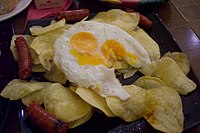Chistorra
 Txistorra pintxo under its typical presentation | |
| Place of origin | Spain |
|---|---|
| Region or state | Navarre |
| Main ingredients | minced pork |
Chistorra or txistorra[1] (pronounced [tʃis̺ˈtora], Basque: txistor) is a type of fast-cure sausage typical of the Basque cuisine, with its origins in Navarre,[2][3] actual Spain. It can be considered a special type of chorizo. It is made of minced pork, or a mixture of minced pork and beef, is encased in either lamb tripe or plastic and has a fat content that varies between 70 and 80%. The sausage is flavoured with garlic, salt and paprika, which gives it a bright-red colour. It is usually baked, fried or grilled and often accompanies other dishes, sometimes as part of tapas. The final cured product tends to be thinner than traditional chorizo or sausage, with a diameter of approximately 25 mm. The sausages average 40 cm (16 in) in length, though there are cases when they reach up to 1 m (3 ft 3 in) long.
It is one of the most typical culinary products of Navarre and the Basque Country, being also found to a smaller extent in neighbouring regions, such as Aragon or Rioja. In Arbizu, a small town in the north of Navarre with a big tradition of txistorra production, a yearly event is celebrated around October, called Txistor Eguna ("Txistorra day").[4]
Since October 2024, its production and commercialisation is protected at EU level by the Chistorra de Navarra − Txistorra de Navarra − Nafarroako Txistorra Protected Geographical Indication.[5]
Preparations
[edit]One of the most popular dishes involving chistorra is huevos rotos con chistorra y patatas, a dish with fried eggs and potatoes.[6]
Chistorra is usually fried whole, but served chopped into smaller sections as a tapa. Fried chistorra is often accompanied by beer or wine, especially of the Txakoli variety. Fried chistorra is also a typical bocadillo (sandwich) filler (bocadillo de chistorra).
Other common dishes include croissant preñado, a croissant with chistorra filler, and tortilla con chistorra, a potato or egg omelet with chistorra.
Chistorra is traditionally served on the feast day of Thomas the Apostle (December 21) in San Sebastián. During the festivities, chistorra is often served alongside talo and is accompanied by cider.[7]
In the Aragonese Pyrenees, there are two different types of txistorra: one made only of pork meat and another made of lungs, boned pig head and the pancreas, called berica.
Today it is sold fresh, but is increasingly found vacuum-packed in Spanish supermarkets.[8]
Tradition
[edit]The 21st of December in the Basque Country is the day of Santo Tomás, during this day in all the cities you can see stalls of artisanal products among which, for being the typical food of the day, the talo, the chistorra and the cider or sagardoa as a usual accompaniment.[9]
-
Huevos rotos con txistorra y patatas, a popular dish
See also
[edit]References
[edit]- ^ "Navarra Chistorra • Reyno Gourmet". Reyno Gourmet. Retrieved 2024-10-31.
- ^ Navarro Velázquez, Miguel (2020-05-20). "La creatividad en la formación del arquitecto, el proceso creativo y las neurociencias". RIDE Revista Iberoamericana para la Investigación y el Desarrollo Educativo. 10 (20). doi:10.23913/ride.v10i20.667. ISSN 2007-7467.
- ^ Beriain, M. J., & Gómez, I. (2022). Chistorra de Navarra: Un embutido tradicional enraizado en expansión. Eurocarne: La revista internacional del sector cárnico, 304, 71-78.
- ^ Mazkiaran, Nerea (2024-10-10). "La txistorra, de Arbizu". Diario de Noticias de Navarra (in Spanish). Retrieved 2024-10-31.
- ^ REGLAMENTO DE EJECUCIÓN (UE) 2024/2793 DE LA COMISIÓN de 24 de octubre de 2024 por el que se establecen disposiciones de aplicación del Reglamento (UE) 2024/1143 del Parlamento Europeo y del Consejo en lo que respecta a la inscripción de una indicación geográfica en el registro de indicaciones geográficas de la Unión [«Chistorra de Navarra/Txistorra de Navarra/Nafarroako Txistorra» (IGP)]
- ^ "Gastronomia spagnola: "La cultura del maiale" | cultura, gastronomia". iNMSOL (in Italian). 2011-03-22. Retrieved 2022-05-30.
- ^ Francia del Sud (in Italian). Touring Editore. 2005. ISBN 978-88-365-3110-3.
- ^ Bartolomé “cheno”, Eugenio (2018-03-29). "A mesa puesta : Txistorra". A mesa puesta. Retrieved 2022-05-30.
- ^ "Organiza tu viaje | Visit Navarra - Web Oficial de Turismo de Navarra". www.visitnavarra.es (in European Spanish). Retrieved 2022-05-30.



